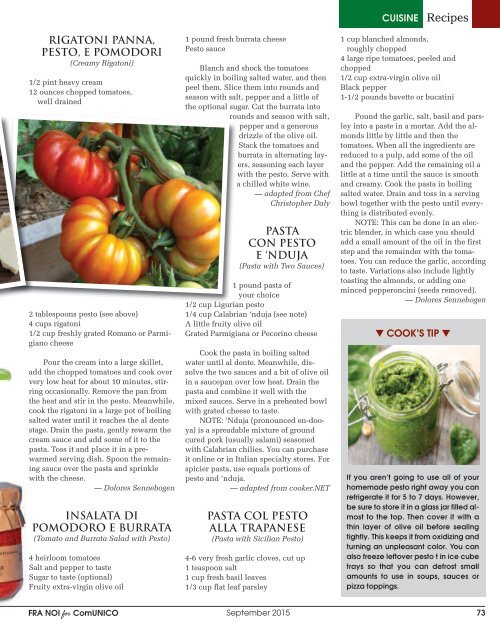UNICO
ComUNICO_SEPT15_Web
ComUNICO_SEPT15_Web
Create successful ePaper yourself
Turn your PDF publications into a flip-book with our unique Google optimized e-Paper software.
CUISINE<br />
Recipes<br />
RIGATONI PANNA,<br />
PESTO, E POMODORI<br />
(Creamy Rigatoni)<br />
1/2 pint heavy cream<br />
12 ounces chopped tomatoes,<br />
well drained<br />
2 tablespoons pesto (see above)<br />
4 cups rigatoni<br />
1/2 cup freshly grated Romano or Parmigiano<br />
cheese<br />
Pour the cream into a large skillet,<br />
add the chopped tomatoes and cook over<br />
very low heat for about 10 minutes, stirring<br />
occasionally. Remove the pan from<br />
the heat and stir in the pesto. Meanwhile,<br />
cook the rigatoni in a large pot of boiling<br />
salted water until it reaches the al dente<br />
stage. Drain the pasta, gently rewarm the<br />
cream sauce and add some of it to the<br />
pasta. Toss it and place it in a prewarmed<br />
serving dish. Spoon the remaining<br />
sauce over the pasta and sprinkle<br />
with the cheese.<br />
— Dolores Sennebogen<br />
INSALATA DI<br />
POMODORO E BURRATA<br />
(Tomato and Burrata Salad with Pesto)<br />
4 heirloom tomatoes<br />
Salt and pepper to taste<br />
Sugar to taste (optional)<br />
Fruity extra-virgin olive oil<br />
1 pound fresh burrata cheese<br />
Pesto sauce<br />
Blanch and shock the tomatoes<br />
quickly in boiling salted water, and then<br />
peel them. Slice them into rounds and<br />
season with salt, pepper and a little of<br />
the optional sugar. Cut the burrata into<br />
rounds and season with salt,<br />
pepper and a generous<br />
drizzle of the olive oil.<br />
Stack the tomatoes and<br />
burrata in alternating layers,<br />
seasoning each layer<br />
with the pesto. Serve with<br />
a chilled white wine.<br />
— adapted from Chef<br />
Christopher Daly<br />
PASTA<br />
CON PESTO<br />
E ‘NDUJA<br />
(Pasta with Two Sauces)<br />
1 pound pasta of<br />
your choice<br />
1/2 cup Ligurian pesto<br />
1/4 cup Calabrian ‘nduja (see note)<br />
A little fruity olive oil<br />
Grated Parmigiana or Pecorino cheese<br />
Cook the pasta in boiling salted<br />
water until al dente. Meanwhile, dissolve<br />
the two sauces and a bit of olive oil<br />
in a saucepan over low heat. Drain the<br />
pasta and combine it well with the<br />
mixed sauces. Serve in a preheated bowl<br />
with grated cheese to taste.<br />
NOTE: ‘Nduja (pronounced en-dooya)<br />
is a spreadable mixture of ground<br />
cured pork (usually salami) seasoned<br />
with Calabrian chilies. You can purchase<br />
it online or in Italian specialty stores. For<br />
spicier pasta, use equals portions of<br />
pesto and ‘nduja.<br />
— adapted from cooker.NET<br />
PASTA COL PESTO<br />
ALLA TRAPANESE<br />
(Pasta with Sicilian Pesto)<br />
4-6 very fresh garlic cloves, cut up<br />
1 teaspoon salt<br />
1 cup fresh basil leaves<br />
1/3 cup flat leaf parsley<br />
1 cup blanched almonds,<br />
roughly chopped<br />
4 large ripe tomatoes, peeled and<br />
chopped<br />
1/2 cup extra-virgin olive oil<br />
Black pepper<br />
1-1/2 pounds bavette or bucatini<br />
Pound the garlic, salt, basil and parsley<br />
into a paste in a mortar. Add the almonds<br />
little by little and then the<br />
tomatoes. When all the ingredients are<br />
reduced to a pulp, add some of the oil<br />
and the pepper. Add the remaining oil a<br />
little at a time until the sauce is smooth<br />
and creamy. Cook the pasta in boiling<br />
salted water. Drain and toss in a serving<br />
bowl together with the pesto until everything<br />
is distributed evenly.<br />
NOTE: This can be done in an electric<br />
blender, in which case you should<br />
add a small amount of the oil in the first<br />
step and the remainder with the tomatoes.<br />
You can reduce the garlic, according<br />
to taste. Variations also include lightly<br />
toasting the almonds, or adding one<br />
minced pepperoncini (seeds removed).<br />
— Dolores Sennebogen<br />
▼ COOK’S TIP ▼<br />
If you aren’t going to use all of your<br />
homemade pesto right away you can<br />
refrigerate it for 5 to 7 days. However,<br />
be sure to store it in a glass jar filled almost<br />
to the top. Then cover it with a<br />
thin layer of olive oil before sealing<br />
tightly. This keeps it from oxidizing and<br />
turning an unpleasant color. You can<br />
also freeze leftover pesto t in ice cube<br />
trays so that you can defrost small<br />
amounts to use in soups, sauces or<br />
pizza toppings.<br />
FRA NOI for Com<strong>UNICO</strong> September 2015 73


